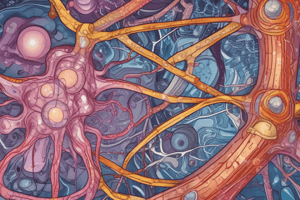Podcast
Questions and Answers
What is the function of C1q in the recognition stage of the classical pathway?
What is the function of C1q in the recognition stage of the classical pathway?
- It releases anaphylatoxin to recruit phagocytes
- It acts as an opsonin that helps in phagocytosis
- It cleaves C4 into C4a and C4b
- It binds to antigen-antibody complex on the surface of a pathogen (correct)
What is the function of C3a in the continue activation stage of the classical pathway?
What is the function of C3a in the continue activation stage of the classical pathway?
- It cleaves C4 into C4a and C4b
- It binds to antigen-antibody complex on the surface of a pathogen
- It is an anaphylatoxin that helps in the recruitment of phagocytes (correct)
- It forms C3-convertase with C4b2a
What is the role of C2b in the activation stage of the classical pathway?
What is the role of C2b in the activation stage of the classical pathway?
- It forms C3-convertase with C4b2a
- It is released in the fluid phase (correct)
- It cleaves C3 into C3a and C3b
- It acts as an opsonin that binds covalently to the surface of the pathogen
What happens to the smaller fragment C4a during the activation stage of the classical pathway?
What happens to the smaller fragment C4a during the activation stage of the classical pathway?
What is formed when C2a remains attached to C4b during the activation stage of the classical pathway?
What is formed when C2a remains attached to C4b during the activation stage of the classical pathway?
Flashcards are hidden until you start studying
Study Notes
Function of C1q in Recognition Stage
- C1q is a crucial protein that initiates the classical complement pathway.
- It recognizes and binds to antibodies (IgM or IgG) that are attached to pathogens or antigen surfaces.
- This binding is essential for the subsequent activation of the complement system.
Function of C3a in Continued Activation Stage
- C3a is a small peptide fragment generated during the complement activation process.
- It functions as an anaphylatoxin, promoting inflammation and recruiting immune cells to sites of infection.
- C3a enhances vascular permeability and contributes to the inflammatory response.
Role of C2b in Activation Stage
- C2b is involved in the formation of the C3 convertase during the classical pathway activation.
- It pairs with C4b to form the C4b2a complex, which is crucial for cleaving C3 into C3a and C3b.
- This conversion is a pivotal step in amplifying the complement cascade.
Fate of C4a During Activation Stage
- C4a is the smaller fragment produced from the cleavage of C4.
- Unlike C4b, which is active in forming enzyme complexes, C4a acts as a weak anaphylatoxin but is rapidly degraded.
- As C4a is released, it plays a minimal role in the overall complement activation process compared to other fragments.
Formation of C4b2a Complex
- When C2a remains attached to C4b, they form the C4b2a complex, known as C3 convertase.
- This complex has a central role in the complement cascade, leading to further cleavage of C3.
- C4b2a effectively enhances the immune response by amplifying complement activation.
Studying That Suits You
Use AI to generate personalized quizzes and flashcards to suit your learning preferences.




